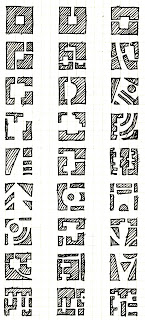'A Pattern Language' by Christopher Alexander - #106 Positive Outdoor Space
illustration of Christopher Alexander's 'Positive Outdoor Space' by Matt Noiseux
One of the books I use in my Landscape Design Studio class in Columbia University is the classic, 'A Pattern Language' by Christopher Alexander. It offers 'patterns' as basic design templates for you to follow.
These are principles of design that are founded on common sense as much as anything else....Alexander says his design language is based on human and natural considerations.....Adding to the delight it that they are numbered for easy reference in the book! 'Accesible Green' is # 60. 'Quiet Backs' is #59.
One of the more elusive patterns is #106 Positive Outdoor Space. It is a favorite of mine. It talks about manipulating outdoor space and refers to space as being 'negative' and 'positive'.
Yin / Yang anyone?
Negative outdoor space is shapeless, the formless residue that surrounds buildings ....
aka 'empty space'...
Positive outdoor space has a distinct and definite shape - its form is as important as the shapes of the buildings which surround it.
Just as the universal Yin Yang symbol illustrates the interrelation of positive and negative, so does great site design.
Make all the outdoor spaces which surround and lie between buildings positive.
Give each one some degree of enclosure; surround each space with wings of buildings, walls, trees, hedges, fences, arcades, and trellised walks,
until it becomes an entity with a positive quality and does not spill out indefinitely around corners.
portion of Hannah Warren's functional diagram...
'A Pattern Language' belongs in all designers' libraries.















That was very interesting! I have never seen this book. It should be of help to us all.
ReplyDeleteGreat post! And great drawings by Matt Noiseux!
ReplyDelete~ Rebecca
Hope you enjoy this collection of natural homes that illustrate 'A Pattern Language'
ReplyDeletehttp://naturalhomes.org/fbr.pattern
Regards, Oliver
I love your Facebook page, Oliver! Naturalhomes.org....
ReplyDeleteSome context.
ReplyDelete'Notes on the Synthesis of Form' is his thesis work. It dates to the early 60's.
'A Pattern Language' (1977, vol 2) & it's original companion; 'The Timeless Way of Building' (1979, vol 1) are his first major works, beyond papers & essays.
Ultimate master work, the 4 book 'The Nature of Order' (Vols 9, 10, 11 & 12) were published in the early noughties, in the years following his retirement from UCB.
In Oct 12, he publish Battle (vol 13).
He also has an unpublished book with the working title of 'Morphogenesis and Sustainability'.
Just reading Patterns is just scratching the surface!
This comment has been removed by the author.
DeleteWhat perfect timing for this Noel - just introduced this book to my class at Columbia last night! I will look fot those other books and esp. Battle, his latest. Thank you very much!
ReplyDeleteThanks for this post, Jan. I am about to complete a degree in hort technology and am taking a plant composition class this semester. Thank you for simplifying and clarifying the definition of positive/negative space. As I left today's class the discussion on this topic felt a bit vague and fuzzy. This post helps. A good thing since we are to find picture examples of positive and negative space!
ReplyDeleteKathie - in 1971 I was studying landscape architecture and the concept of positive/negative space was all the rage...but no one could explain it to me.
DeleteThe space 'in between' physical elements can be defined well or just be amorphous. Trees can make as space positive too..Read Alexander's description of Tree Places.
I talk about line and space in a chapter in my upcoming book, "Heaven is a Garden". You can pre-order it on Amazon for March, 2014.